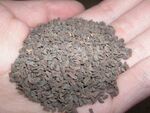Peganum harmala: Difference between revisions
>David Hedlund Added more refs for the alkaloid content |
>David Hedlund Linked RIMA |
||
| Line 9: | Line 9: | ||
*[[Harmine]], 0.44%<ref name=chroma>{{cite journal |vauthors=Pulpati H, Biradar YS, Rajani M |title=High-performance thin-layer chromatography densitometric method for the quantification of harmine, harmaline, vasicine, and vasicinone in Peganum harmala |journal=J AOAC Int |volume=91 |issue=5 |pages=1179–85 |year=2008 |pmid=18980138}}</ref>–1.84%<ref name=partial/>–4.3%<ref name=new1>{{cite journal |vauthors=Herraiz T, González D, Ancín-Azpilicueta C, Arán VJ, Guillén H |title=beta-Carboline alkaloids in Peganum harmala and inhibition of human monoamine oxidase (MAO) |journal=Food Chem. Toxicol. |volume=48 |issue=3 |pages=839–45 |date=March 2010 |pmid=20036304 |doi=10.1016/j.fct.2009.12.019}}</ref> | *[[Harmine]], 0.44%<ref name=chroma>{{cite journal |vauthors=Pulpati H, Biradar YS, Rajani M |title=High-performance thin-layer chromatography densitometric method for the quantification of harmine, harmaline, vasicine, and vasicinone in Peganum harmala |journal=J AOAC Int |volume=91 |issue=5 |pages=1179–85 |year=2008 |pmid=18980138}}</ref>–1.84%<ref name=partial/>–4.3%<ref name=new1>{{cite journal |vauthors=Herraiz T, González D, Ancín-Azpilicueta C, Arán VJ, Guillén H |title=beta-Carboline alkaloids in Peganum harmala and inhibition of human monoamine oxidase (MAO) |journal=Food Chem. Toxicol. |volume=48 |issue=3 |pages=839–45 |date=March 2010 |pmid=20036304 |doi=10.1016/j.fct.2009.12.019}}</ref> | ||
:The coatings of the seeds are said to contain large amounts of harmine.<ref name=cdfa/> Harmine is a nonselective MAO-A and MAO-B inhibitor. The coatings of the seeds are said to contain large amounts of harmine. | :The coatings of the seeds are said to contain large amounts of harmine.<ref name=cdfa/> Harmine is a nonselective MAO-A and MAO-B inhibitor. The coatings of the seeds are said to contain large amounts of harmine. | ||
*[[Harmaline]], 0.25%<ref name=partial/>–0.79%<ref name=chroma/>–5.6%<ref name=new1/> Harmaline is a | *[[Harmaline]], 0.25%<ref name=partial/>–0.79%<ref name=chroma/>–5.6%<ref name=new1/> Harmaline is a [[RIMA]].<ref>{{ cite book | author = Massaro, E. J. | title = Handbook of Neurotoxicology | publisher = Humana Press | location = Totowa, NJ | year = 2002 | isbn = 0-89603-796-7 | url = https://books.google.com/books?id=2c2K-epbCDQC&pg=PA237&lpg=PA237&dq=harmaline+antidepressant | page = 237 }}</ref> | ||
*[[Harmalol]], 0.6%<ref name=new1/>–3.90%<ref name=partial/> | *[[Harmalol]], 0.6%<ref name=new1/>–3.90%<ref name=partial/> | ||
*[[Tetrahydroharmine]], 0.1%<ref name=new1/> | *[[Tetrahydroharmine]], 0.1%<ref name=new1/> | ||
Revision as of 08:21, 25 October 2018
| Peganum harmala | |
|---|---|
 P. harmala in the nature. |
|
| Taxonomical nomenclature | |
| Kingdom | Plantae |
| Unranked | Angiosperms |
| Unranked | Eudicots |
| Unranked | Rosids |
| Order | Sapindales |
| Family | Nitrariaceae |
| Genus | Peganum |
| Species | P. harmala |
| Common nomenclature | |
| Common names | Espand, Esfand, Syrian rue |
| Constituents | |
| Active constituents | Harmala alkaloid |
Peganum harmala, commonly called Syrian rue, harmel, espand, esfand, wild rue, African rue, or aspand, is a plant native to the eastern Iranian region west to India. It has also spread invasively throughout Arizona, California, Montana, Nevada, Oregon, Texas and Washington.[1] The plant itself produces seeds which contain harmala alkaloids and is easily accessible and legal to purchase online.
Chemistry

Powdered syrian rue seeds act as a MAOI at doses of 2-5g. Syrian rue seeds contain several different harmala alkaloids at slightly varying percentages. Only some are monoamine oxidase A inhibitors. In one study, total harmala alkaloids were at least 5.9% of dried weight.[2][3]
- The coatings of the seeds are said to contain large amounts of harmine.[9] Harmine is a nonselective MAO-A and MAO-B inhibitor. The coatings of the seeds are said to contain large amounts of harmine.
- Harmaline, 0.25%[4]–0.79%[7]–5.6%[8] Harmaline is a RIMA.[10]
- Harmalol, 0.6%[8]–3.90%[4]
- Tetrahydroharmine, 0.1%[8]
- Total harmala alkaloids were at least 5.9% of dried weight, in one study.[4]
Drug use in pregnancy
Peganum harmala is used traditionally as an abortifacient agent in Morocco, North Africa, and the Middle East.[12] It is believed that quinazoline alkaloids such as vasicine and vasicinone are responsible for the abortifacient activity of the plant.[13]
See also
External links
References
- ↑ https://plants.usda.gov/core/profile?symbol=PEHA
- ↑ http://www.phcogrev.com/article.asp?issn=0973-7847;year=2013;volume=7;issue=14;spage=199;epage=212;aulast=Moloudizargari
- ↑ http://www.tandfonline.com/doi/abs/10.1080/15563650701323205
- ↑ 4.0 4.1 4.2 4.3 4.4 Hemmateenejad B, Abbaspour A, Maghami H, Miri R, Panjehshahin MR (August 2006). "Partial least squares-based multivariate spectral calibration method for simultaneous determination of beta-carboline derivatives in Peganum harmala seed extracts". Anal. Chim. Acta. 575 (2): 290–9. doi:10.1016/j.aca.2006.05.093. PMID 17723604.
- ↑ https://www.ncbi.nlm.nih.gov/pubmed/16139309
- ↑ https://www.ncbi.nlm.nih.gov/pubmed/8149995
- ↑ 7.0 7.1 7.2 7.3 Pulpati H, Biradar YS, Rajani M (2008). "High-performance thin-layer chromatography densitometric method for the quantification of harmine, harmaline, vasicine, and vasicinone in Peganum harmala". J AOAC Int. 91 (5): 1179–85. PMID 18980138.
- ↑ 8.0 8.1 8.2 8.3 Herraiz T, González D, Ancín-Azpilicueta C, Arán VJ, Guillén H (March 2010). "beta-Carboline alkaloids in Peganum harmala and inhibition of human monoamine oxidase (MAO)". Food Chem. Toxicol. 48 (3): 839–45. doi:10.1016/j.fct.2009.12.019. PMID 20036304.
- ↑ Cite error: Invalid
<ref>tag; no text was provided for refs namedcdfa - ↑ Massaro, E. J. (2002). Handbook of Neurotoxicology. Totowa, NJ: Humana Press. p. 237. ISBN 0-89603-796-7.
- ↑ 11.0 11.1 Cite error: Invalid
<ref>tag; no text was provided for refs namednook - ↑ https://www.hindawi.com/journals/criem/2014/783236/
- ↑ https://www.sciencedirect.com/topics/agricultural-and-biological-sciences/zygophyllaceae